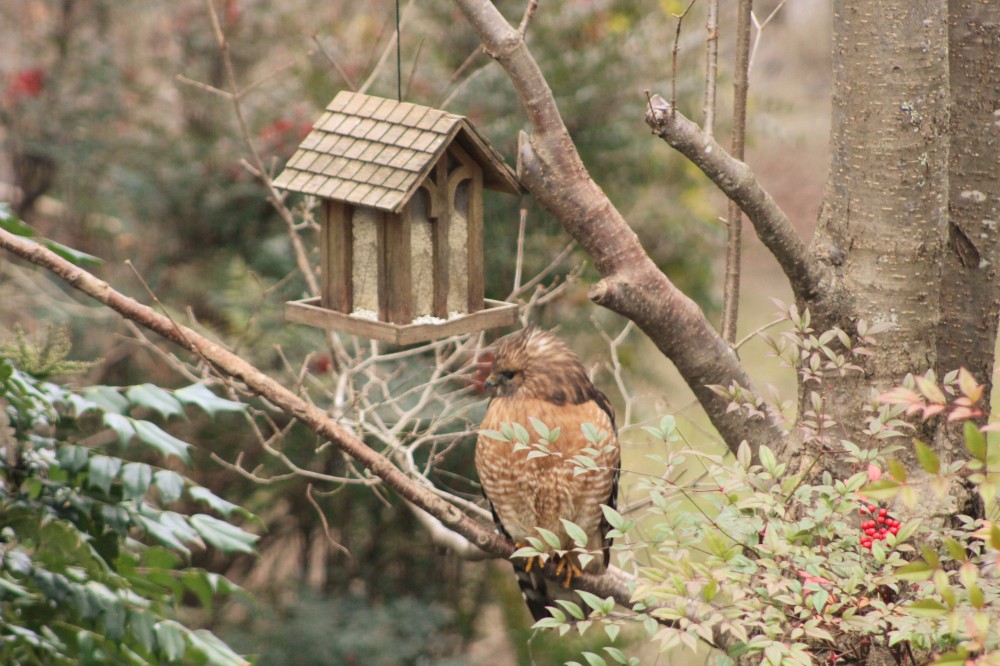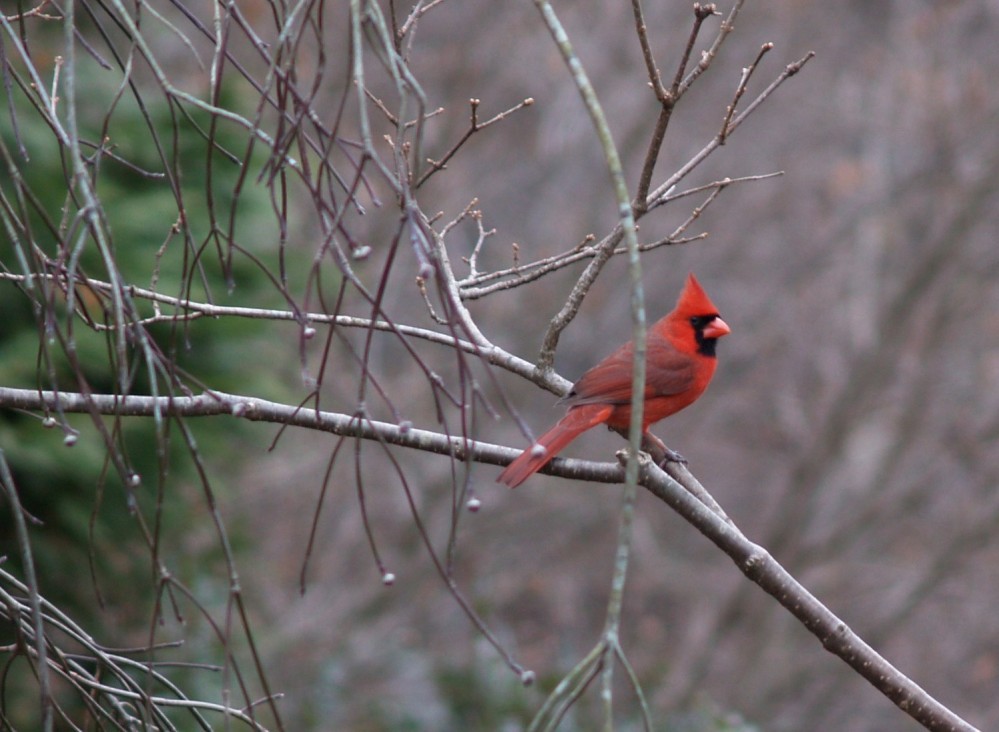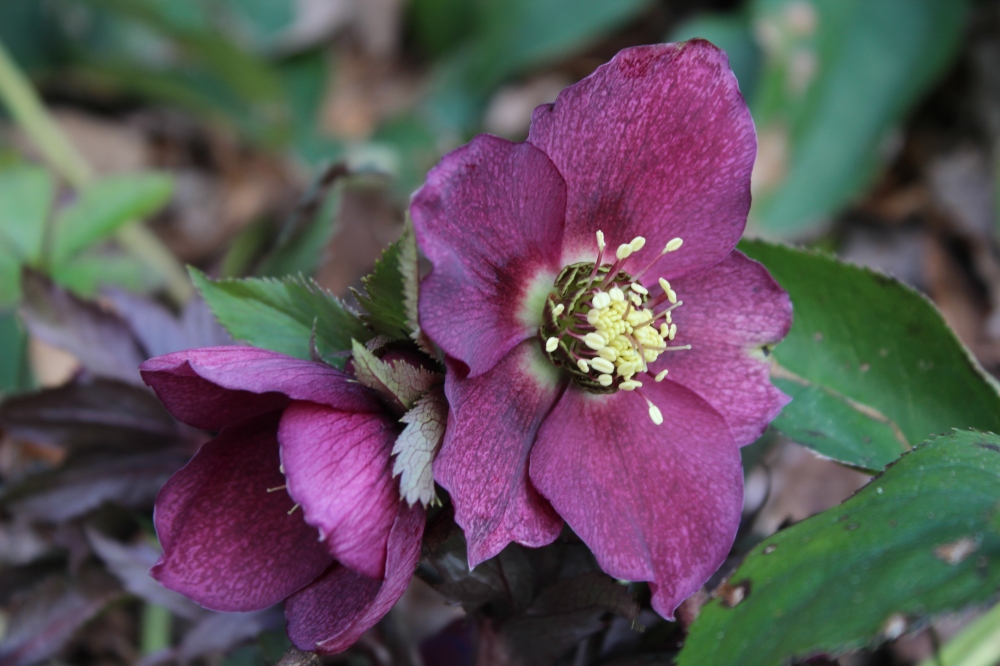This very unscientific research, based entirely upon casual observation, is concluding nicely, and perhaps the last phase to measure the reaction of squirrels to being shot in the hindquarters by BB’s will not be necessary. Time spent by neighborhood squirrels at our birdfeeder has steadily declined with a switch to sunflower seed treated with hot pepper sauce, and now to safflower seed, as suggested by a reader in Haymarket, a few miles up the road from here.

While banging on windows and loudly shouted threats of violence did little, the pepper treated seed was moderately effective, discouraging several regulars, and shortening the time at the feeder for the few stubborn holdouts. While a redtailed hawk (above) proved most effective, warding away squirrels, but also birds, a more complete deterrent was desired, and after several days it appears the answer could be safflower seed.

Yes, squirrels sampled the new seed, but seemingly found it undesirable, cutting short their stays at the feeder, and then not returning except one that partially dismantled the feeder in hopes that choicer seeds must be hidden within. The smaller safflower seeds tumbled from the open window of the feeder into a mound on the ground below. Now, cardinals inhabit the feeder while chickadees forage on the ground, and no squirrels have been seen on this pleasantly chilly afternoon. Somewhat curiously, no bluejays have been observed at the feeder since the change in seed, though they seem to come and go and very probably will return.

In the surrounding garden, the effects of recent mild temperatures are readily apparent, with many early snowdrops and hellebores (above) coming into bloom, and buds of hybrid witch hazels beginning to open to join the earlier flowering Vernal witch hazel (Hamamelis vernalis, below). While cooler weather is forecast, the lack of extreme cold will encourage flowering to progress.
Prospects for February are excellent. Without squirrels at the feeder, my wife will be happier, and possibly the kitchen will be more peaceful without the banging and shouting. And, the gardener will be enthused further by the increasing numbers of blooms.
So jealous of your beautiful blooms. We won’t see those for 6 weeks yet, if we are lucky. Keep reminding us that spring is inching its way towards us!
Occasionally, I feel slight guilt in showing photos of winter flowers while readers in much colder areas are covered by snow. But, only a little. I’m happy to be here, and to have a somewhat mild winter so far.
Years ago I went through your thoughts and ideas regarding squirrels. They were chewing my feeders apart. I also banged on the windows – to little effect. I finally got my BB gun out and shot a few. But I stopped that pretty quickly as other squirrels replaced them and I also had to dispose of bloody carcasses. My subsequent solution was to replace all of my bird feeders with squirrel-proof feeders – the kind with a spring-loaded mesh covering. Worked great. The squirrels and I have now been at peace for over 30 years, and the squirrels and birds both love the copious amounts of sunflower seed I feed them! (The squirrels eat the fallen seed)
I hear so often that squirrel proof feeders are not, so I’ve been working through alternatives. While squirrels are obviously not attracted to safflower seed, I’m not so certain that cardinals and chickadees are thrilled with it. But, there’s a twenty pound bag to go through and then I’ll see where I go next. Almost certainly, it will not involve shooting BB’s.
Not surprised that no reference is made to the marketplace reality of
Safflower Seed pricing from 5-lbs. to 50-lbs. bags. While I have long
known of this so-called squirrel-proof option, it is cost-prohibitive on
my budget. Unfortunately, last Fall, it became necessary to extricate
two well-devised and located bird feeders due to squirrels’ destructive
tactics, unrelenting aggressive behavior toward birds, and the eating
of near-every single black sunflower seed on-ground (which, of course,
a number of birds seek with pleasure as long as the area is shielded
and safe from predators). My hawks have been visible, yet apparently
have discovered these squirrels to be both too-ugly and noxious.
I am very aware of price differences between sunflower and safflower seeds, but the equation is complicated with squirrels eating a substantial share of sunflower seeds. I was fortunate to find Tractor Supply selling safflower seed for under $1 per pound, and with birds eating nearly 100% of the seed, it lasts at least twice as long as sunflower seed.